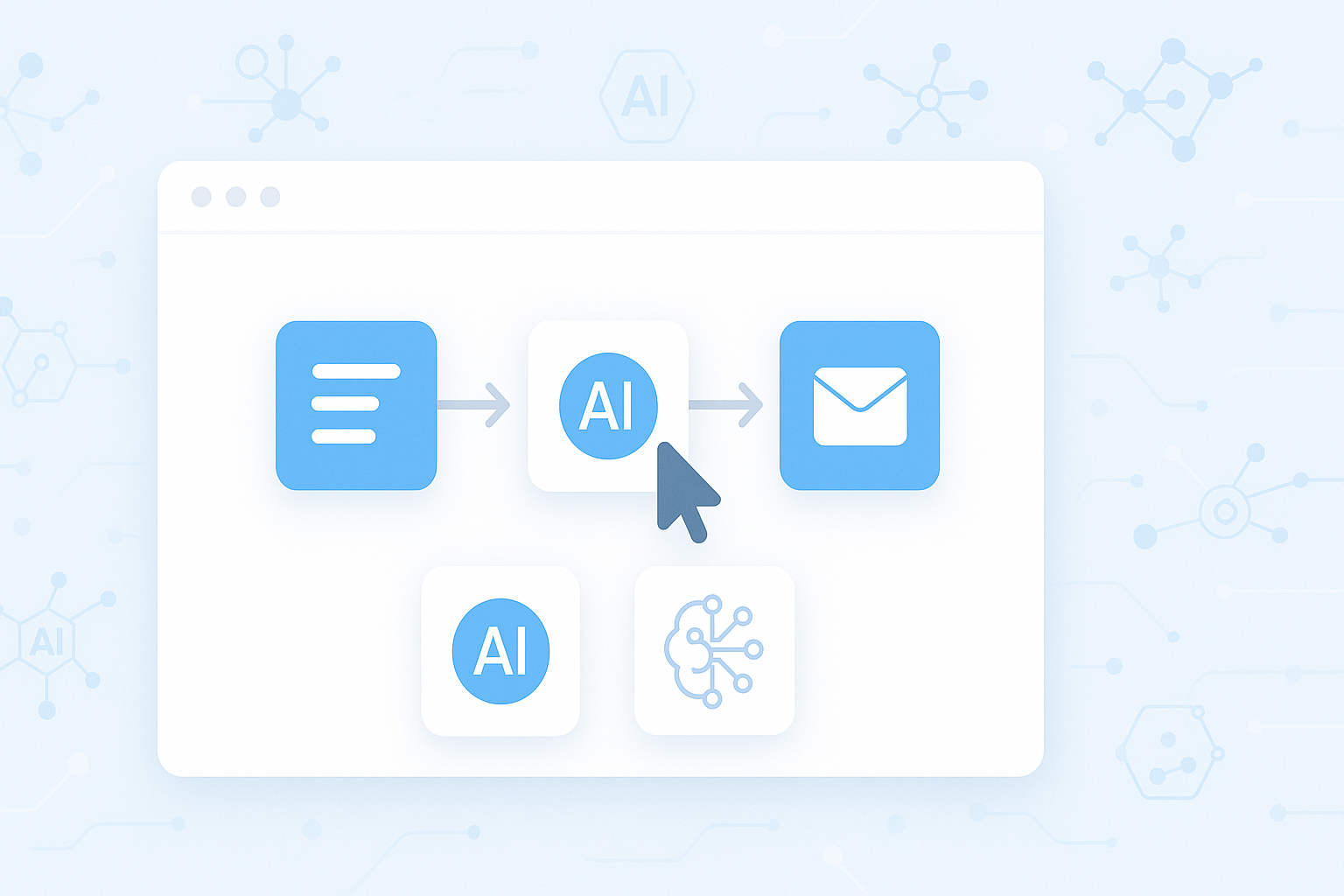Key Steps for a Successful AI Implementation Strategy in U.S. Businesses

Artificial intelligence has become the defining technology of the decade. Across the United States, from the financial centers of New York City to the innovation clusters in Los Angeles and the growing energy tech scene in Houston, AI is reshaping how companies operate, make decisions, and compete. Yet, while adoption is accelerating, success is not guaranteed.

Many organizations are still struggling to translate AI investments into measurable outcomes. A clear and methodical AI implementation strategy—not just the tools themselves—determines whether innovation becomes an advantage or a sunk cost. This article breaks down the key steps U.S. businesses should take to ensure AI initiatives create sustainable value, backed by current data and real-world examples from major economic regions.
Understanding the Challenge: Why Many AI Projects Fail
Despite the excitement, most AI initiatives underperform. According to a 2024 McKinsey & Company study, more than 60% of AI projects in U.S. enterprises fail to scale due to a lack of business alignment, data readiness, and workforce adaptation (source).
The problem is not the algorithms but the absence of a cohesive roadmap. Businesses often deploy AI reactively—purchasing tools or platforms without defining the problems they aim to solve. A successful strategy requires balancing technology, people, and process within a broader digital transformation framework.
Common failure factors include:
- Vague or unrealistic ROI expectations.
- Siloed data and inconsistent governance.
- Insufficient AI literacy among teams.
- Underestimating infrastructure requirements.
- Lack of post-deployment monitoring or retraining.
These issues can be prevented with a disciplined approach built on five foundational steps.
Step 1: Define Clear Business Goals
The first step in any AI implementation strategy is defining measurable objectives that directly support the company’s core business priorities. AI should never exist in isolation; it should answer a tangible question like:
- How can we reduce customer churn by 10%?
- Which repetitive tasks consume the most employee hours?
- Where can predictive analytics improve forecasting accuracy?
For instance, financial institutions in New York City are using machine learning not just for fraud detection but also to reduce false positives in compliance monitoring—saving millions in unnecessary manual reviews. Meanwhile, retailers in Miami are leveraging recommendation engines to improve personalization and increase average order value.
Defining KPIs early allows leadership to measure success objectively. Companies that set outcome-based metrics are 3.5 times more likely to achieve positive ROI within the first year, according to the Harvard Business Review (source).
Step 2: Build a Robust Data Infrastructure

Data quality determines AI performance. No model, regardless of sophistication, can outperform the integrity of its inputs. Before launching large-scale AI initiatives, companies must invest in data infrastructure that ensures accessibility, accuracy, and compliance.
This involves:
- Consolidating data silos into centralized data lakes or warehouses.
- Implementing consistent metadata and labeling standards.
- Enforcing privacy and security protocols aligned with U.S. regulations (GDPR equivalents, state laws, etc.).
- Establishing continuous data pipelines for model retraining.
In Houston, the energy sector provides a compelling example. Companies are combining IoT sensor data with predictive AI models to anticipate equipment failure and minimize downtime. But these systems only work because they rely on high-quality, time-stamped operational data from multiple plants and sensors.
A 2024 EY research survey found that 83% of executives believe poor data governance limits their AI impact (source). Investing in scalable, clean, and well-structured data infrastructure is not optional—it’s a prerequisite for sustainable AI success.
Step 3: Select Scalable Tools and Implementation Partners

Choosing the right AI tools is more about interoperability than brand names. Companies should look for platforms that integrate with their existing tech stacks, support APIs, and offer flexibility for future scaling.
The rise of no-code and low-code platforms—like Airtable, FlutterFlow, and OpenAI APIs—has made it easier for mid-market firms to experiment with automation without large engineering teams. These tools empower operations managers, marketers, and analysts to build AI workflows aligned with their business functions.
In Los Angeles, media production companies are adopting AI to automate repetitive editing tasks and content tagging, using custom-built no-code systems that reduce turnaround time by 40%. Similarly, Austin startups are integrating open AI models into CRM platforms to generate insights from customer interactions.
The key is not to chase every new model or vendor. Instead, businesses should prioritize flexibility, scalability, and transparent pricing models that match their operational maturity.
Step 4: Train and Empower the Workforce
Technology without people is powerless. True AI transformation happens when employees understand how to use it effectively and trust its outcomes. This requires structured upskilling programs and cultural alignment.
According to MIT Sloan Management Review, companies with high AI literacy are five times more likely to report strategic benefits from AI (source).
Successful organizations often:
- Conduct internal workshops on AI fundamentals.
- Create hybrid roles such as “AI Operations Lead” or “Data Translator.”
- Develop governance committees that include IT, business, and compliance leaders.
- Celebrate small AI wins to build confidence.
In Austin, workforce alliances have been established to train local employees in applied AI, connecting universities and private companies. Meanwhile, Boston corporations are integrating AI fluency into leadership development programs to prepare executives for data-driven decision-making.
AI success depends as much on human adaptability as on algorithmic precision.
Step 5: Start Small, Then Scale Fast
The most effective AI transformations begin with narrow, well-defined pilot projects. A pilot serves as a proof of concept to test assumptions, validate ROI, and refine workflows before broader rollout.
For example:
- A healthcare startup in Los Angeles launched an AI scheduling assistant that improved patient throughput by 22% before expanding it to other clinics.
- A manufacturing company in Chicago used computer vision for quality inspection on one assembly line, later scaling across facilities nationwide.
The objective is not perfection but learning. Once a pilot delivers consistent results, companies can replicate it across departments, geographies, or subsidiaries. This iterative scaling builds credibility and de-risks larger investments.
As noted by Forbes Technology Council, “The fastest-growing AI adopters are those who balance agility with accountability—starting small but thinking big” (source).
Regional Insights: How AI Implementation Differs Across U.S. Cities
New York City – Finance and Compliance
AI adoption in New York revolves around risk management, trading analytics, and fraud detection. Leading banks are using NLP models to process regulatory filings and detect anomalies faster than manual audits.
Los Angeles – Media, Marketing, and Creativity
Creative industries in LA leverage AI for video production, script analysis, and content recommendation systems, integrating human creativity with data-driven insights.
Houston – Energy and Industrial Efficiency
The city’s industrial backbone benefits from AI-enabled predictive maintenance and environmental monitoring, helping companies cut operational costs while improving safety standards.
Miami – Fintech and E-Commerce Acceleration
Startups in Miami are using AI to automate customer onboarding, detect transaction anomalies, and enhance personalization in online retail experiences.
These examples show how local ecosystems influence AI implementation priorities. Businesses should align strategies with regional strengths and regulatory landscapes.
Governance, Ethics, and Long-Term Sustainability
AI governance is no longer optional. As adoption deepens, companies must address data privacy, algorithmic bias, and transparency to maintain trust with customers and regulators.
Establishing ethical guardrails includes:
- Creating internal AI ethics committees.
- Documenting data provenance and consent.
- Regularly auditing models for bias and accuracy.
- Ensuring compliance with U.S. federal and state laws.
The U.S. Chamber of Commerce emphasizes that trustworthy AI not only protects reputation but also enhances competitiveness (source). Ethical AI is now a business differentiator, not a compliance checkbox.
Measuring Success: Turning AI into ROI
AI should be treated like any other strategic investment—with clear KPIs and performance dashboards. Metrics may include:
- Cost reduction percentage.
- Revenue uplift from personalization or automation.
- Time saved in process cycles.
- Employee satisfaction with AI tools.
- Accuracy improvement in forecasts or recommendations.
Regular measurement helps recalibrate models and identify new opportunities. In some cases, companies find that combining AI with automation or data visualization tools produces compounding returns.
The Future of AI Implementation in the U.S.
The next wave of AI adoption will blend autonomous decision-making with contextual human oversight. As generative AI matures, businesses will shift from automating tasks to redesigning entire workflows.
Cities like New York, Austin, and San Francisco are emerging as AI innovation corridors, while mid-sized metros—like Atlanta and Denver—are investing in workforce readiness and AI-driven logistics.
For small and mid-market firms, the opportunity is massive. With accessible tools and cloud infrastructure, they can compete with enterprise-level players without heavy capital expenditure.
However, success depends on discipline: integrating AI gradually, evaluating real results, and maintaining transparency.
Conclusion: From Vision to Execution
Artificial intelligence is transforming how U.S. businesses grow, but technology alone is not the differentiator—execution is. By defining measurable goals, investing in clean data, choosing scalable tools, training people, and starting with focused pilots, companies can turn AI into a growth engine instead of an experiment.
The organizations leading the next decade will be those that integrate AI not as a side project but as a core business capability—grounded in purpose, strategy, and accountability.
Ready to start your AI transformation?
Start your AI Automation Plan with Singular Innovation
Heading
Dolor enim eu tortor urna sed duis nulla. Aliquam vestibulum, nulla odio nisl vitae. In aliquet pellentesque aenean hac vestibulum turpis mi bibendum diam. Tempor integer aliquam in vitae malesuada fringilla.
Mi tincidunt elit, id quisque ligula ac diam, amet. Vel etiam suspendisse morbi eleifend faucibus eget vestibulum felis. Dictum quis montes, sit sit. Tellus aliquam enim urna, etiam. Mauris posuere vulputate arcu amet, vitae nisi, tellus tincidunt. At feugiat sapien varius id.
Heading 3
Eget quis mi enim, leo lacinia pharetra, semper. Eget in volutpat mollis at volutpat lectus velit, sed auctor. Porttitor fames arcu quis fusce augue enim. Quis at habitant diam at. Suscipit tristique risus, at donec. In turpis vel et quam imperdiet. Ipsum molestie aliquet sodales id est ac volutpat.
Tristique odio senectus nam posuere ornare leo metus, ultricies. Blandit duis ultricies vulputate morbi feugiat cras placerat elit. Aliquam tellus lorem sed ac. Montes, sed mattis pellentesque suscipit accumsan. Cursus viverra aenean magna risus elementum faucibus molestie pellentesque. Arcu ultricies sed mauris vestibulum.
Heading 4
Morbi sed imperdiet in ipsum, adipiscing elit dui lectus. Tellus id scelerisque est ultricies ultricies. Duis est sit sed leo nisl, blandit elit sagittis. Quisque tristique consequat quam sed. Nisl at scelerisque amet nulla purus habitasse.

Heading 5
Morbi sed imperdiet in ipsum, adipiscing elit dui lectus. Tellus id scelerisque est ultricies ultricies. Duis est sit sed leo nisl, blandit elit sagittis. Quisque tristique consequat quam sed. Nisl at scelerisque amet nulla purus habitasse.
"Ipsum sit mattis nulla quam nulla. Gravida id gravida ac enim mauris id. Non pellentesque congue eget consectetur turpis. Sapien, dictum molestie sem tempor. Diam elit, orci, tincidunt aenean tempus."
Heading 6
Nunc sed faucibus bibendum feugiat sed interdum. Ipsum egestas condimentum mi massa. In tincidunt pharetra consectetur sed duis facilisis metus. Etiam egestas in nec sed et. Quis lobortis at sit dictum eget nibh tortor commodo cursus.
What is Singular Innovation
Lorem ipsum dolor sit amet, consectetur adipiscing elit. Suspendisse varius enim in eros elementum tristique.




.png)

